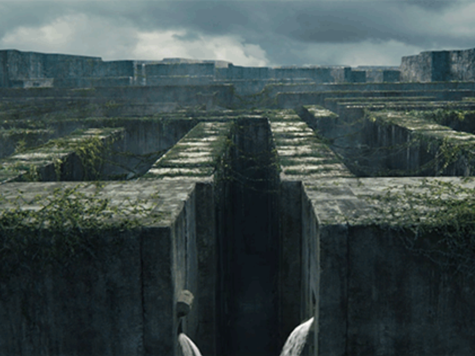What say we stop for a moment to express our gratitude to this recent spate of teen dystopian thrillers that have replaced the awful run of teen fantasy films spawned by the dreadful “Harry Potter” franchise. “The Maze Runner” might not be anything more than an extended episode of a fairly memorable “Twilight Zone” episode, but Lost Boys on the run from mechanical spiders sure beats the hell out of praying for the sweet release of death at the sight of a Quidditch match.
“Maze Runner” doesn’t just borrow heavily from Peter Pan and Rod Serling’s timeless sci-fi series. There’s a dash of “Lord of the Flies,” and a whole heaping helping of Vincenzo Natali’s brilliant 1997 sci-fi thriller “Cube,” which is also about disparate people with no memory of how they got there having to think and fight their way out of a giant, dangerous puzzle constructed by God Only Knows.

Thomas (Dylan O’Brien) regains consciousness in a freight elevator going up, up, up. It finally stops in the middle of a vast glade surrounded by walls as high as skyscrapers. Behind those walls is a giant, impenetrable maze. He’s greeted by a couple dozen other teen-aged boys, the first of whom arrived under the exact same circumstance three years ago.
In-between accepting a new resident every month, the boys built their own hierarchy and agrarian society. Everyone has a task. Some build. Some tend crops. Others gather water and firewood from a nearby forest. The smartest and fittest are maze runners. Every morning after the Skull Island-sized doors open, two runners are tasked with mapping the endless maze in the hopes of finding a way out. If they are unable to return before the maze closes that evening, they will never return.
In this deeply troubling Age of Obama, another reason to be grateful for these “Hunger Games” wannabes, is the healthy message — by accident or design — being delivered to The Young and Impressionable. Whether it’s Katniss, “The Giver,” or “Divergent,” the arch-villain is always Big Government — a despot disguised as a nanny; liberty vs. the soul-killing stability of Statism.

Thomas, as you would expect, is different from the others. The film’s story and theme take a nice turn as soon as the buzzword “coexist” is hurled. Some of the boys are unwilling to trade the security of their present situation with the risks involved in breaking the unspoken rules laid down by their jailers. Stability under the thumb of an oppressor, they believe, is preferable to a costly war for freedom.
Guess which side our hero falls on.
One thing “The Maze Runner” does EXTREMELY well is time the answers to its many intriguing questions. They mystery of it all is rolled out beautifully. The Big Question, which is answered in the film’s final minutes, left me feeling more than a little cheated. This is, though, the age of The Franchise.
All bow to the needs of The Franchise.
What this potential franchise most lacks is a Jennifer Lawrence; a bona fide, standout, four-alarm movie star to make it feel like a MOVIE and not a two-part television episode. Which isn’t to say “Maze Runner” isn’t entertaining and even exciting at times.
The story and ideas behind it are imaginative enough to welcome the promised and inevitable sequel.
John Nolte on Twitter @NolteNC

COMMENTS
Please let us know if you're having issues with commenting.